Sephora Marketing Strategy: Best Case Study for Shopify Brands

If you’re running a Shopify brand and looking for marketing inspiration that actually works in today’s fast-paced, content-heavy world—look no further than Sephora. Known for its powerhouse presence in the beauty industry, Sephora marketing strategy is a case study in building community, creating personalized experiences via mobile app, and driving long-term brand loyalty. In this guide, we’ll break down how Sephora does it so well—and more importantly, how you can apply the same principles to your own e-commerce business.
>> Read more:
- Fashion Nova Marketing Strategy: An In-Depth Analysis
- Decoding Gymshark Marketing Strategy: A Comprehensive Analysis
- 9 Mobile Marketing Case Studies You Need to Bookmark
1. Overview of Sephora
Sephora stands as a global leader in the prestige beauty retail sector, operating under the umbrella of the luxury conglomerate LVMH Moët Hennessy Louis Vuitton since 1997. Founded in Limoges, France, in 1969 by Dominique Mandonnaud, the company revolutionized beauty retail with its unique “open-sell” environment, allowing customers direct access to products.
Today, Sephora operates an extensive global network, encompassing over 2,700 stores across 35 countries, including a significant presence of over 500 stores in the Americas. Its global footprint includes more than 3,000 points of sale and over 30 e-commerce sites, supported by a workforce of approximately 52,000 employees. The company’s U.S. journey began in 1998 with its first store in New York’s SoHo neighborhood, followed by the launch of its U.S. e-commerce site, Sephora.com, in 1999, which quickly became its largest North American “store”.
Sephora’s core purpose is explicitly stated as championing “a world of inspiration and inclusion where everyone can celebrate their beauty”. This mission is deeply intertwined with the belief that beauty thrives in diversity and discovery.

>> Read more: Sephora Net Worth, Revenue 2024 & Growth Strategy Analysis: How Shopify Brands Can Learn From?
2. Sephora Target Market
Sephora primarily targets women aged 18-35, with a focus on beauty enthusiasts who value luxury, quality, and innovation in personal care products. This demographic includes millennials and Gen Z, who are digitally savvy, trend-conscious, and willing to invest in premium beauty items. The brand appeals to upper-middle and high-income consumers who see beauty as a form of self-expression and a status symbol.
- Geographically, Sephora caters to urban markets globally, with a strong presence in North America, Europe, and increasingly in Asia, such as India and China.
- Psychographically, its audience comprises individuals who follow global beauty trends, engage with influencers, and seek personalized, experiential shopping. Sephora also emphasizes inclusivity, offering products for diverse skin tones, ages, and beauty needs, broadening its appeal beyond its core demographic.
3. Sephora Competitors Analysis
Sephora operates in a highly competitive beauty retail landscape, facing challenges from a mix of traditional retailers, direct-to-consumer (DTC) brands, and regional players. Below is a detailed analysis of its key competitors, focusing on their strengths, weaknesses, and how they stack up against Sephora’s market positioning.
| Competitor | Strengths | Weaknesses | Comparison to Sephora |
| Ulta Beauty | Wide price range, strong loyalty program, in-store salons | Less luxury focus, limited global reach | Broader accessibility vs. Sephora’s premium edge |
| MAC Cosmetics | High-quality makeup, strong brand identity | Narrow product range, single-brand focus | Makeup expertise vs. Sephora’s variety |
| Nykaa (India) | Localized offerings, influencer marketing | Limited global presence, less experiential | Regional dominance vs. Sephora’s luxury appeal |
| DTC Brands (Glossier, Fenty) | Niche loyalty, inclusivity, agile launches | Limited physical presence, smaller range | Digital disruption vs. Sephora’s omnichannel |
| Department Stores (Macy’s, Nordstrom) | Established trust, exclusive deals | Less beauty specialization, outdated experience | Traditional appeal vs. Sephora’s modern focus |
Ulta Beauty
Ulta Beauty is one of Sephora’s fiercest competitors in the U.S., operating over 1,300 stores as of 2025. Unlike Sephora’s luxury focus, Ulta combines high-end brands (e.g., Estée Lauder, Too Faced) with mass-market options (e.g., NYX, L’Oréal), appealing to a broader customer base.
Strengths:
- Offers a wider price range, attracting both budget-conscious and premium shoppers.
- Robust loyalty program (Ultamate Rewards) with points-based incentives driving repeat purchases.
- In-store salons offering hair, skin, and brow services, adding experiential value Sephora lacks.
Weaknesses:
- Less emphasis on a luxury shopping experience compared to Sephora’s sleek, upscale store design.
- Limited international presence, with operations primarily confined to the U.S.
Comparison to Sephora: Ulta’s hybrid model gives it an edge in accessibility and variety, but Sephora outshines it in global reach, exclusive brand partnerships, and tech-driven innovation (e.g., Virtual Artist tools). Sephora’s premium positioning also appeals more to aspirational beauty enthusiasts.
MAC Cosmetics
MAC Cosmetics, owned by Estée Lauder, is a professional-grade makeup brand with standalone stores and a strong presence in department stores. It competes directly with Sephora’s high-end makeup offerings.
Strengths:
- Renowned for quality, vibrant colors, and a cult following among makeup artists and enthusiasts.
- Strong brand identity tied to creativity and inclusivity (e.g., Viva Glam campaigns supporting HIV/AIDS awareness).
Weaknesses:
- Narrower product range, focusing solely on makeup rather than skincare, fragrance, or haircare.
- Operates as a single-brand entity, lacking Sephora’s multi-brand curation and variety.
Comparison to Sephora: MAC’s expertise in makeup makes it a formidable rival in that category, but Sephora’s broader portfolio and retail experience (e.g., sampling, consultations) give it a significant advantage. Sephora also sells MAC products, diluting MAC’s standalone threat.
Nykaa (India)
Nykaa, an Indian beauty e-commerce platform turned omnichannel retailer, has rapidly grown since its founding in 2012. With over 2,500 offline stores and a strong online presence, it challenges Sephora in Asia’s emerging markets.
Strengths:
- Deep understanding of the Indian market, offering localized products and affordable pricing alongside luxury brands.
- Aggressive influencer marketing and content-driven approach (e.g., Nykaa Beauty Book blog, YouTube tutorials).
- Private label (Nykaa Luxe, Nykaa Naturals) competes directly with Sephora Collection.
Weaknesses:
- Limited global footprint compared to Sephora’s international network.
- Less focus on in-store experiential elements like Sephora’s Beauty Advisors or AR tools.
Comparison to Sephora: Nykaa’s regional dominance and affordability give it an edge in India, but Sephora counters with a stronger luxury appeal, global brand equity, and a more sophisticated digital ecosystem. Sephora’s expansion into India since 2012 has intensified this rivalry.
Direct-to-Consumer Brands (e.g., Glossier, Fenty Beauty)
DTC brands like Glossier and Fenty Beauty (the latter founded by Rihanna and partially distributed through Sephora) have disrupted the beauty industry by selling directly online, bypassing traditional retail.
Strengths:
- Glossier: Minimalist, millennial-focused branding with a loyal community built via social media.
- Fenty Beauty: Pioneered inclusivity with 50+ foundation shades, resonating with diverse audiences and setting industry trends.
- Both leverage agile product launches and authentic storytelling to connect with Gen Z and millennials.
Weaknesses:
- Limited physical presence reduces tactile shopping experiences Sephora excels at.
- Smaller product ranges compared to Sephora’s extensive catalog.
Comparison to Sephora: These brands challenge Sephora by cultivating niche loyalty and cutting out the middleman, but Sephora mitigates this threat by partnering with them (e.g., selling Fenty Beauty) and offering a one-stop shop for multiple DTC and legacy brands. Sephora’s omnichannel strength also outpaces their digital-only focus.
Department Stores (e.g., Macy’s, Nordstrom)
Traditional department stores like Macy’s and Nordstrom maintain beauty counters featuring premium brands (e.g., Chanel, Dior), competing with Sephora for the luxury beauty consumer.
Strengths:
- Established trust and foot traffic from a broader retail ecosystem (clothing, home goods).
- Exclusive brand deals and seasonal promotions (e.g., Macy’s holiday gift sets).
Weaknesses:
- Lack the immersive, beauty-specific experience Sephora provides (e.g., sampling stations, tech integrations).
- Smaller beauty focus within a diversified product offering dilutes specialization.
Comparison to Sephora: Department stores appeal to older, traditional shoppers, but Sephora’s modern, beauty-centric approach—complete with in-store services and digital tools—captures younger, trend-driven audiences more effectively.
4. Sephora SWOT Analysis
A SWOT analysis provides a framework for understanding Sephora’s internal capabilities and external market environment.
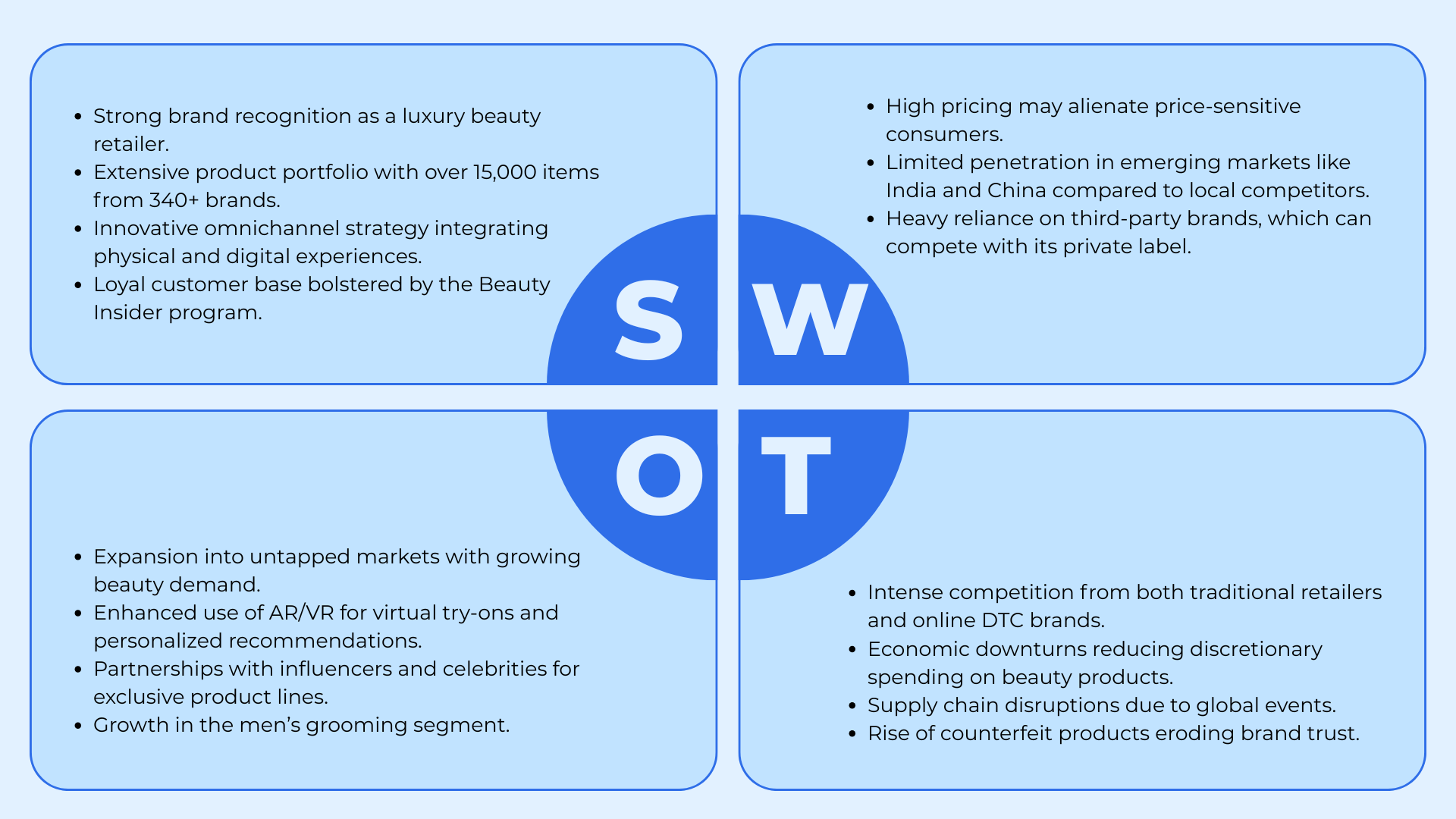
4.1. Strengths
- Established Brand Reputation & Image: Sephora enjoys strong global recognition as a premier destination for prestige beauty. Its brand image is cohesive across all channels, associated with luxury, quality, innovation, and inclusivity.
- Exceptional Customer Experience: The unique “open-sell” environment encourages exploration, complemented by the “try-before-you-buy” philosophy and extensive sampling. Stores offer a high-sensory experience, enhanced by knowledgeable, brand-agnostic Beauty Advisors providing personalized consultations and services like makeovers and classes (e.g., TIP Workshops).
- Diverse & Curated Product Portfolio: Sephora offers an extensive range of products (estimates range from 17,000 to over 45,000 SKUs) from hundreds of brands (340+ to nearly 500) across makeup, skincare, fragrance, and haircare.2 The curation includes classic luxury names, popular contemporary brands, emerging indie labels, exclusive launches (like Fenty Beauty and Rare Beauty), and a robust private label (Sephora Collection). There’s a clear commitment to diversity in assortment through initiatives like the 15 Percent Pledge.
- Strong Digital Presence & Omnichannel Integration: Sephora excels in blending its digital and physical channels. Its e-commerce site (Sephora.com) and mobile app are highly developed and integrated with the store network, offering features like Buy Online, Pick Up In Store (BOPIS), inventory checking, and shared customer profiles. Digital marketing efforts (SEO, social media, ads) are robust. The company pioneers the use of technology like AI and AR (Virtual Artist, Color IQ) to enhance the customer journey both online and in-store.
- Effective Marketing & Community Engagement: Sephora employs innovative marketing strategies, with a strong emphasis on its Beauty Insider loyalty program, which drives significant customer retention and sales.3 The brand actively builds community through online forums, social media interaction, and events. Its influencer marketing program (#SephoraSquad) is highly successful in generating authentic content and engagement.
- Global Retail Footprint: An extensive network of strategically located stores in 35 countries provides significant market presence and brand visibility.3
- LVMH Ownership: Being part of the world’s leading luxury group provides substantial financial resources, operational synergies, stability, and access to a portfolio of high-end brands.
- Employer Reputation (Mixed): Sephora has received recognition as a desirable employer (e.g., Forbes, HRC Corporate Equality Index) and promotes an inclusive workplace. However, this is counterbalanced by reported weaknesses (see below).
4.2. Weaknesses
- High Price Perception: The premium positioning and focus on luxury brands lead to a perception of high prices, potentially alienating budget-conscious consumers and limiting market share among price-sensitive segments.
- Limited Appeal to Mass Market: The deliberate focus on prestige beauty inherently excludes consumers primarily seeking drugstore or mass-market options.
- Cost of Customer Experience: Maintaining the high-touch, technologically advanced, and experiential store environment is resource-intensive and expensive.14 There’s a risk associated with customers utilizing the experience (sampling, consultations) without making purchases.
- Reliance on Developed/European Markets: Historically, Sephora’s strength has been concentrated in North America and Europe, leading to potential over-reliance on these mature markets. Penetration in key emerging markets, particularly in Asia (India, China), has been comparatively weaker.
- Channel Dilution/Brand Conflict: Selling products from brands that directly compete with its own private label, Sephora Collection, can create internal conflict, confuse customers, or potentially dilute the private label’s positioning. Conflicts between partner brands have also been noted as a potential issue.
- Inventory Management: Some analyses suggest Sephora may have a higher Days Inventory Outstanding (DII) compared to competitors, indicating potentially less efficient inventory turnover and tying up capital.
- Employee Issues (Mixed): Reports mention a potentially high employee attrition rate compared to industry rivals, leading to increased recruitment and training costs. Past allegations related to racial profiling and discrimination have also surfaced, posing reputational risks despite stated inclusivity goals.
- Limited Focus on Men’s Segment: While offering some products for men, the range and marketing focus are significantly smaller compared to the women’s segment, potentially missing growth opportunities in the expanding men’s grooming market.
4.3. Opportunities
- Expansion in Emerging Markets: Significant growth potential exists in untapped or underpenetrated markets, particularly in Asia (India, China, Southeast Asia) where consumer spending on quality beauty products is rising. Tailoring offerings, potentially including popular local Asian brands, could accelerate growth.
- Growth in Men’s Grooming Market: Capitalize on the growing demand for men’s skincare and cosmetic products by expanding the product assortment and developing targeted marketing campaigns for this segment.
- Strengthening E-commerce & Digital Innovation: Continue investing in the online platform and mobile app, enhancing features, personalization capabilities (using AI/AR and data analytics), and potentially optimizing dynamic pricing strategies globally.
- Focus on Sustainability & Clean Beauty: Leverage the increasing consumer demand for sustainable, eco-friendly, natural, and “clean” beauty products by expanding the “Clean at Sephora” initiative, introducing more sustainable packaging, and clearly communicating these efforts.
- Enhance Inclusivity Efforts: Build further upon the “We Belong to Something Beautiful” platform and the 15 Percent Pledge to deepen connections with diverse consumer groups and reinforce positive brand values.
- Private Label Expansion: Grow the Sephora Collection by entering new product categories or targeting specific trending beauty niches, increasing profitability and differentiation.
- Strategic Partnerships & Collaborations: Continue securing exclusive brand launches and collaborations. Expand successful partnership models like Sephora at Kohl’s to reach new customer bases. Deepen relationships with influencers across various tiers.
- Subscription Services: Explore or expand subscription-based models, potentially offering curated discovery boxes or replenishment services.
- Leverage Market Knowledge: Utilize extensive experience and accumulated customer data to anticipate market trends, understand evolving consumer needs, and adapt strategies proactively.
>> See more: 7 Best White Label Beauty Products Dropshipping Suppliers in 2025
4.4. Threats
- Intense Competition: The beauty retail market is highly saturated and competitive, with pressure from direct rivals like Ulta, revitalized department stores, mass retailers entering the prestige space (Target/Ulta), powerful online platforms (Amazon, TikTok Shop), and numerous DTC brands. Differentiation remains a constant challenge, alongside price pressure from lower-cost alternatives.
- Changing Consumer Preferences: Rapid shifts in beauty trends (e.g., towards minimalism or specific aesthetics), evolving values (e.g., heightened focus on sustainability, ingredient transparency), and changing shopping behaviors (e.g., increased online research, social commerce) require continuous adaptation.
- Economic Uncertainty/Downturns: Recessions or economic slowdowns can lead to reduced consumer spending on discretionary luxury goods like premium beauty products. Consumers may trade down to more affordable alternatives available at drugstores or mass retailers.
- Rise of Direct-to-Consumer (DTC) Brands: An increasing number of beauty brands are building their own e-commerce capabilities and selling directly to consumers, potentially bypassing retailers like Sephora and weakening its negotiating power or access to certain brands.
- Counterfeit Products & Gray Market: The proliferation of fake or unauthorized products damages brand reputation, erodes consumer trust, and diverts potential revenue.
- Supply Chain Disruptions: Global supply chain vulnerabilities can impact product availability and inventory levels. Inflation in raw material costs can also squeeze margins.
- Digital Disruption: The emergence of new digital platforms and social commerce channels (e.g., TikTok Shop) can rapidly alter consumer discovery and purchasing pathways, requiring constant monitoring and potential strategy shifts. Staying ahead of digital trends is crucial.
- Data Privacy & Cybersecurity Concerns: Growing consumer awareness and regulatory scrutiny regarding data privacy necessitate transparent data handling practices and robust cybersecurity measures to prevent breaches and maintain trust.
- Regulatory & Compliance Challenges: Operating globally requires navigating a complex web of varying regulations related to product safety, ingredients, marketing, and business operations across different countries.
- Negative PR/Controversies: Past incidents related to racial profiling allegations or controversies around fake reviews demonstrate the potential for significant damage to brand image and customer trust. Careful management of public relations and social media presence is essential.
5. Sephora Marketing Mix Strategy (4Ps)
Sephora marketing strategy’s success is underpinned by a well-defined and integrated marketing mix strategy, encompassing Product, Price, Place, and Promotion.
5.1. Product
Sephora’s product strategy is centered on offering a vast, curated, and diverse assortment that caters to beauty enthusiasts’ varied needs and preferences. Key aspects include:
- Breadth and Variety: Sephora stocks over 15,000 products from more than 340 brands, spanning makeup, skincare, fragrances, haircare, and beauty tools. This includes luxury names like La Mer and Dior, trendy brands like Fenty Beauty, and its own affordable Sephora Collection private label.
- Inclusivity: The product range addresses diverse skin tones, types, and beauty goals, with offerings like Fenty’s 50+ foundation shades and skincare tailored to specific concerns (e.g., anti-aging, acne).
- Exclusivity: Sephora secures exclusive partnerships and limited-edition launches with influencers, celebrities, and brands (e.g., Pat McGrath Labs, Huda Beauty), keeping its catalog fresh and buzzworthy.
- Innovation: The brand emphasizes cutting-edge beauty solutions, such as clean beauty lines, vegan products, and tech-enhanced tools like the Pantone Color IQ for personalized foundation matching.
- Private Label: Sephora Collection provides high-quality, budget-friendly alternatives, broadening its appeal without compromising the luxury image.
5.2. Pricing
Sephora’s pricing strategy aligns with its premium positioning while incorporating tactics to enhance perceived value and accessibility. Key elements include:
- Premium Pricing: Reflecting its luxury status, Sephora prices products at a premium level, with high-end items like a $250 La Mer cream or $80 Creed fragrance targeting affluent consumers who associate cost with quality.
- Tiered Options: The inclusion of mid-range brands (e.g., Too Faced, Urban Decay) and the affordable Sephora Collection (e.g., $10 lipsticks) creates a pricing spectrum that widens its customer base without diluting its upscale image.
- Value-Added Incentives: The Beauty Insider loyalty program offsets premium pricing by offering points redeemable for discounts, free samples, and exclusive perks across three tiers (Insider, VIB, Rouge). For example, Rouge members spending $1,000 annually gain early access to sales and free shipping.
- Strategic Promotions: Limited-time sales (e.g., annual Spring Savings Event) and gift-with-purchase offers maintain exclusivity while encouraging purchases, balancing profitability with customer satisfaction.
5.3. Place (Distribution)
Sephora’s distribution strategy is built on a sophisticated omnichannel model, seamlessly integrating its physical retail presence with powerful digital platforms. The goal is to provide a consistent and convenient experience wherever the customer chooses to shop.
- Physical Stores: With over 2,700 locations worldwide as of 2025, Sephora targets high-traffic urban areas and upscale malls. Stores are designed as experiential hubs with sleek black-and-white aesthetics, sampling stations, and Beauty Advisor consultations.
- Shop-in-Shops: Partnerships with retailers like Kohl’s (over 900 locations by 2025) and JCPenney extend Sephora’s reach into suburban markets, blending its premium vibe with broader accessibility.
- E-Commerce: Sephora’s website supported by Shopify and its mobile app offers a full product catalog, exclusive online-only items, and features like BOPIS (Buy Online, Pick Up In-Store), virtual try-ons, and personalized recommendations powered by AI. The brand operates in 35 countries, with aggressive growth in Asia (e.g., India since 2012, China via Tmall) and Europe, tailoring store formats and product selections to local preferences.
Supporting this network are Distribution Centers that manage the logistics for both physical stores and online fulfillment. This integrated omnichannel strategy allows Sephora to leverage the experiential strengths of its stores while capitalizing on the convenience, personalization, and reach of its digital platforms and strategic partnerships.

5.4. Promotion
Sephora’s promotional strategy emphasizes experiential marketing, community building, and leveraging digital tools to drive engagement and sales. Key tactics include:
- “Try Before You Buy” Philosophy: In-store sampling, makeup tutorials, and tech tools like the Virtual Artist AR feature let customers test products risk-free, reducing purchase hesitation and enhancing satisfaction.
- Beauty Insider Program: This tiered loyalty system rewards purchases with points, exclusive events, and birthday gifts, fostering repeat business. For instance, Rouge members enjoy VIP experiences like Sephoria, a beauty festival blending education and entertainment.
- Influencer and Social Media Marketing: Sephora collaborates with beauty influencers and celebrities on platforms like Instagram and TikTok to promote products and campaigns (e.g., #SephoraSquad ambassador program), tapping into authentic peer recommendations.
- Content Creation: The brand produces tutorials, trend guides, and user-generated content (UGC) campaigns (e.g., #LipStories) to educate and inspire its audience, boosting organic engagement.
- Events and Campaigns: High-profile initiatives like the “We Belong to Something Beautiful” inclusivity campaign or holiday gift guides amplify brand visibility and emotional connection.
- Email and Personalized Ads: Targeted email blasts and retargeting ads deliver promotions based on customer browsing history, ensuring relevance and driving conversions.
6. Sephora Digital Marketing Strategy
Sephora’s digital marketing strategy is a critical component of its overall success, characterized by sophisticated use of data, technology, and platform integration to create a seamless and personalized customer journey.
6.1. SEO (Website)
Sephora’s website is a powerhouse of organic traffic, optimized to rank highly on search engines and deliver a user-friendly experience. Key elements of its SEO strategy include:
- Keyword Optimization: Sephora targets high-intent beauty-related keywords such as “make up”, “skincare”, “perfume”, “best foundation,” “luxury skincare brands,” or “makeup trends 2025.” These terms are strategically embedded in product descriptions, blog posts, and category pages to capture search volume from Google and other engines.
- Content-Rich Pages: The site features detailed product listings with customer reviews, ingredient lists, and usage tips, boosting relevance and dwell time. Additionally, Sephora’s Beauty Insider Community and “Beauty Offers” pages provide evergreen content like tutorials and trend guides, enhancing authority and keyword rankings.
- Technical SEO: Fast page load speeds, mobile responsiveness, and a clean URL structure (e.g., sephora.com/makeup-cosmetics) improve crawlability and user experience, critical factors for Google’s algorithm. The site also uses schema markup to enhance rich snippets (e.g., star ratings in search results).
- Personalization: AI-driven tools analyze user behavior to suggest products, increasing engagement and reducing bounce rates—indirectly supporting SEO performance.
- Local SEO: Store locator pages optimized with city-specific keywords (e.g., “Sephora New York”) drive foot traffic to physical locations, bridging online and offline channels.

Sephora website traffic reached 11.3M/month in Mar 2025 with 9.2M as branded intent (by Afref)
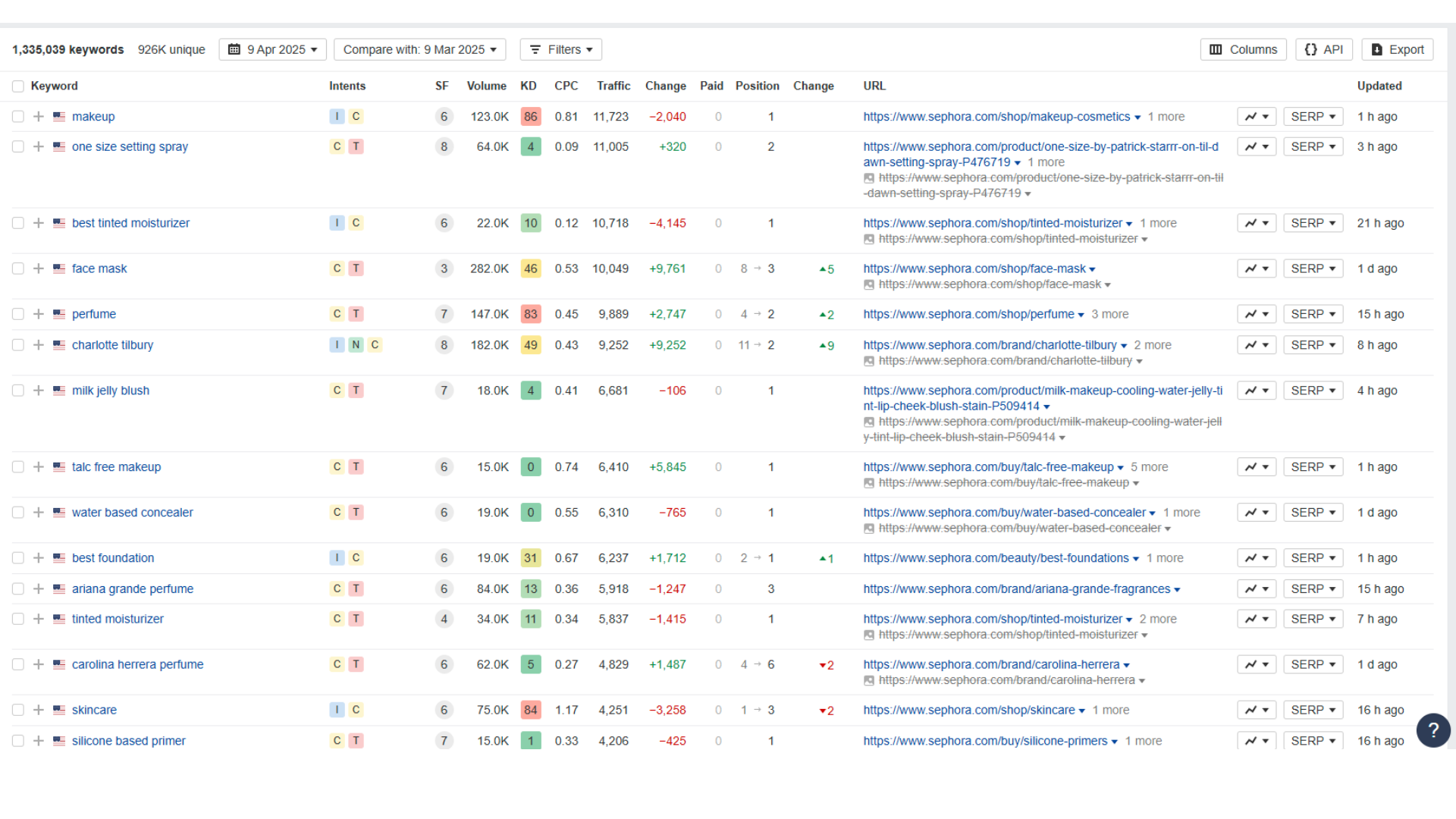
6.2. ASO (Sephora Mobile App)
Sephora’s mobile app is a vital part of its digital ecosystem, optimized for visibility and downloads through App Store Optimization (ASO). Key tactics include:
- App Title and Keywords: The app’s title, “Sephora – Buy Makeup & Skincare,” incorporates broad, high-traffic keywords like “makeup” and “skincare.” Additional keywords in the app store description (e.g., “beauty shopping,” “virtual try-on”) target specific user searches on iOS App Store and Google Play.
- Visual Appeal: High-quality screenshots and videos showcase standout features like the Virtual Artist (AR makeup try-ons), Beauty Insider tracking, and in-app exclusives, enticing users to download. Eye-catching icons align with Sephora’s sleek branding.
- User Ratings and Reviews: With a 4.8+ rating on both platforms (as of 2025), positive reviews boost credibility and rankings. Sephora encourages feedback through in-app prompts and rewards, maintaining high scores.
- Frequent Updates: Regular updates introduce new features (e.g., AR hair color try-ons in 2024) and fix bugs, signaling to app stores that it’s actively maintained—improving visibility in search results.
- Localization: The app is tailored to regional markets (e.g., language options, local promotions), enhancing relevance and downloads in countries like France, India, and China.

Sephora mobile app on Google play
Tips: For Shopify store owners who want to reach more customers on mobile without the hassle of coding or expensive development, Simicart is the easiest no-code mobile app builder that allows you to quickly create and launch your own iOS and Android apps. Unlike complex or costly solutions, Simicart offers a simple drag-and-drop interface and a free plan to effortlessly tap into the power of mobile commerce.
>> Contact us now to get a demo
6.3. Sephora Digital Ads
Sephora’s digital advertising strategy is a sophisticated blend of paid channels, targeting precision, and creative execution to maximize reach and ROI. Key components include:
- Google Ads: Sephora runs search and display ads tied to high-intent keywords (e.g., “buy lipstick online”) and retargeting campaigns for users who’ve browsed its site. Product Listing Ads (PLAs) showcase specific items with prices and images, appearing atop Google Shopping results.
- Social Media Ads: Platforms like Instagram, TikTok, and YouTube are central to Sephora’s ad strategy:
- Instagram: Shoppable posts and Stories feature visually stunning product demos, often tied to influencer collaborations (e.g., #SephoraSquad).
- TikTok: Short, trend-driven videos (e.g., “Get Ready With Me” using Sephora products) leverage viral hashtags and Gen Z appeal, with a 491% surge in impressions noted in 2023 campaigns.
- YouTube: Longer-form tutorials and brand films target beauty learners, often linked to product pages.
- Programmatic Advertising: Sephora uses data-driven display ads across websites and apps, targeting users based on demographics, interests (e.g., beauty, fashion), and past behavior. Dynamic ads personalize content, showing products users viewed or added to carts.
- Influencer Partnerships: Paid collaborations with micro- and macro-influencers amplify ad reach organically, embedding products in authentic content. For example, the 2023 Sephora Collection TikTok campaign with influencers yielded a 1013% ROI increase.
- Seasonal and Event-Based Ads: Campaigns tied to holidays (e.g., Black Friday) or exclusives (e.g., Fenty Beauty drops) use urgency and scarcity tactics, driving clicks and sales with limited-time offers.
- Personalization and Analytics: Ads are tailored using customer data from Beauty Insider profiles and browsing history, ensuring relevance. Sephora tracks performance via metrics like click-through rates (CTR) and cost-per-acquisition (CPA), optimizing campaigns in real time.
7. Sephora Marketing Strategy Examples (Successful Campaigns)
Sephora’s marketing success is illustrated by numerous effective campaigns and ongoing strategic initiatives that leverage technology, personalization, community, and omnichannel integration.
7.1. Beauty Insider Loyalty Program & Events
More than a campaign, Beauty Insider is a foundational element of Sephora’s strategy. Launched in 2007, it evolved with tiers (VIB in 2009, Rouge in 2013) based on annual spend. Its objective is to drive loyalty, increase spending, gather data, and build community.11 Execution involves points for rewards (products, exclusive experiences like beauty classes or tours), tiered discounts (especially during VIB Sales), birthday gifts, free samples, early product access, and an integrated online community forum.
The program is immensely impactful, with members reportedly accounting for 80% of North American sales and numbering over 25-66 million globally (figures vary by source and scope). Sephora continues to innovate, exploring gamification through “Beauty Insider Challenges”.

7.2. #SephoraSquad Influencer Program
An ongoing initiative launched in 2019, Sephora selects a diverse cohort of beauty influencers annually to create authentic content. The program utilizes micro, macro, and nano influencers across platforms like Instagram, TikTok, and YouTube. The objective is to generate genuine user-generated content, build brand awareness and trust, and promote products to targeted audiences.
Execution involves a rigorous application process, providing influencers with exclusive access and products, and using platforms like Lefty to manage relationships and track performance. The program has proven highly effective, generating significant social media impressions and high ROI on specific campaigns (e.g., +1013% ROI on a TikTok campaign for Sephora Collection).
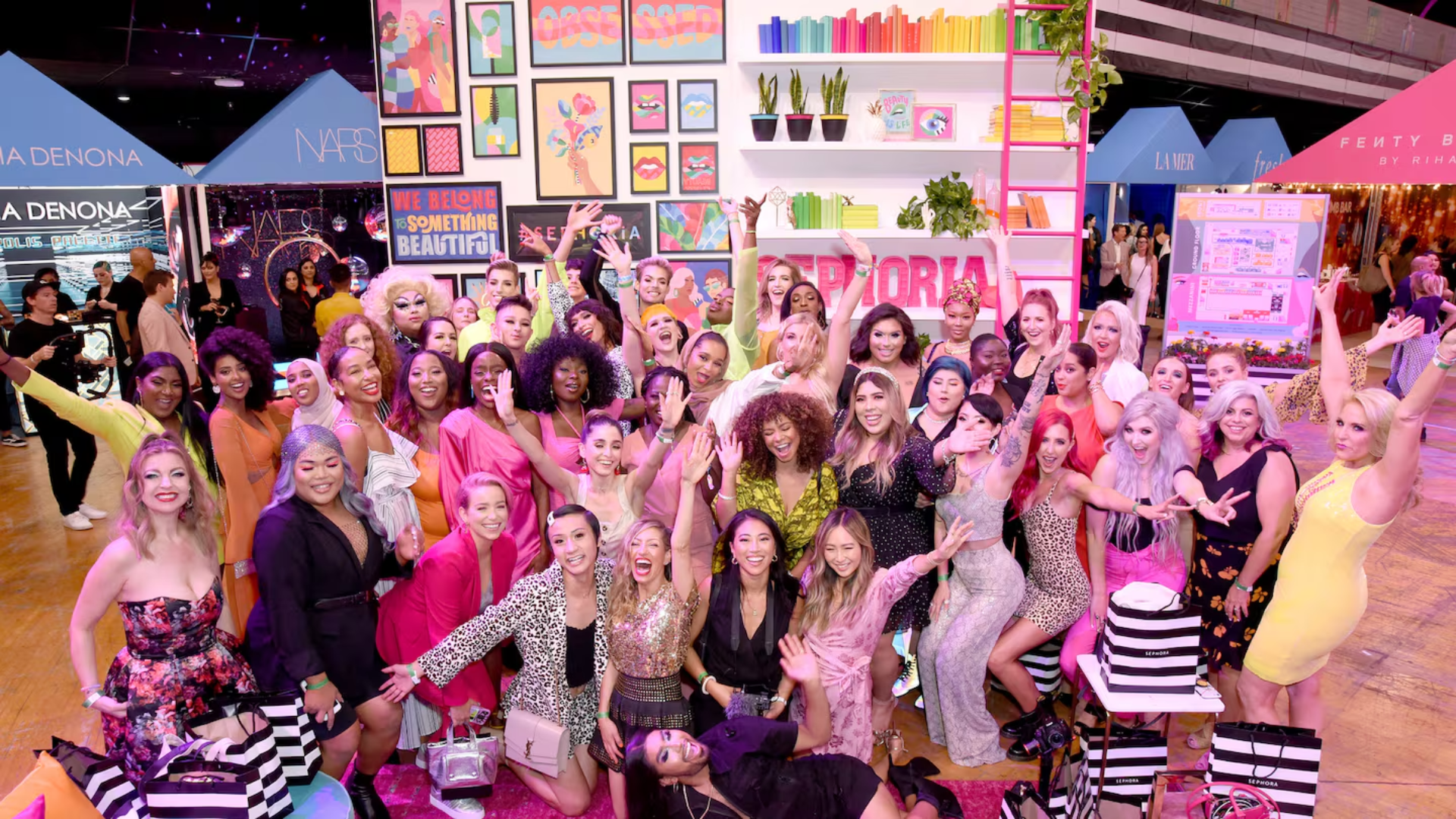
7.3. “We Belong to Something Beautiful” Campaign
This brand manifesto and tagline, introduced in 2019, centers on inclusivity, diversity, and fostering a sense of belonging among all clients and employees. The objective was to reinforce Sephora’s core values, connect emotionally with consumers, promote a more inclusive vision for beauty retail, and differentiate the brand.
Execution involved integrating the message across all marketing channels (ads, social media, website, in-store) and backing it with tangible actions like the 15 Percent Pledge. The campaign successfully strengthened Sephora’s brand image around inclusivity, resonating with consumers who value diversity.
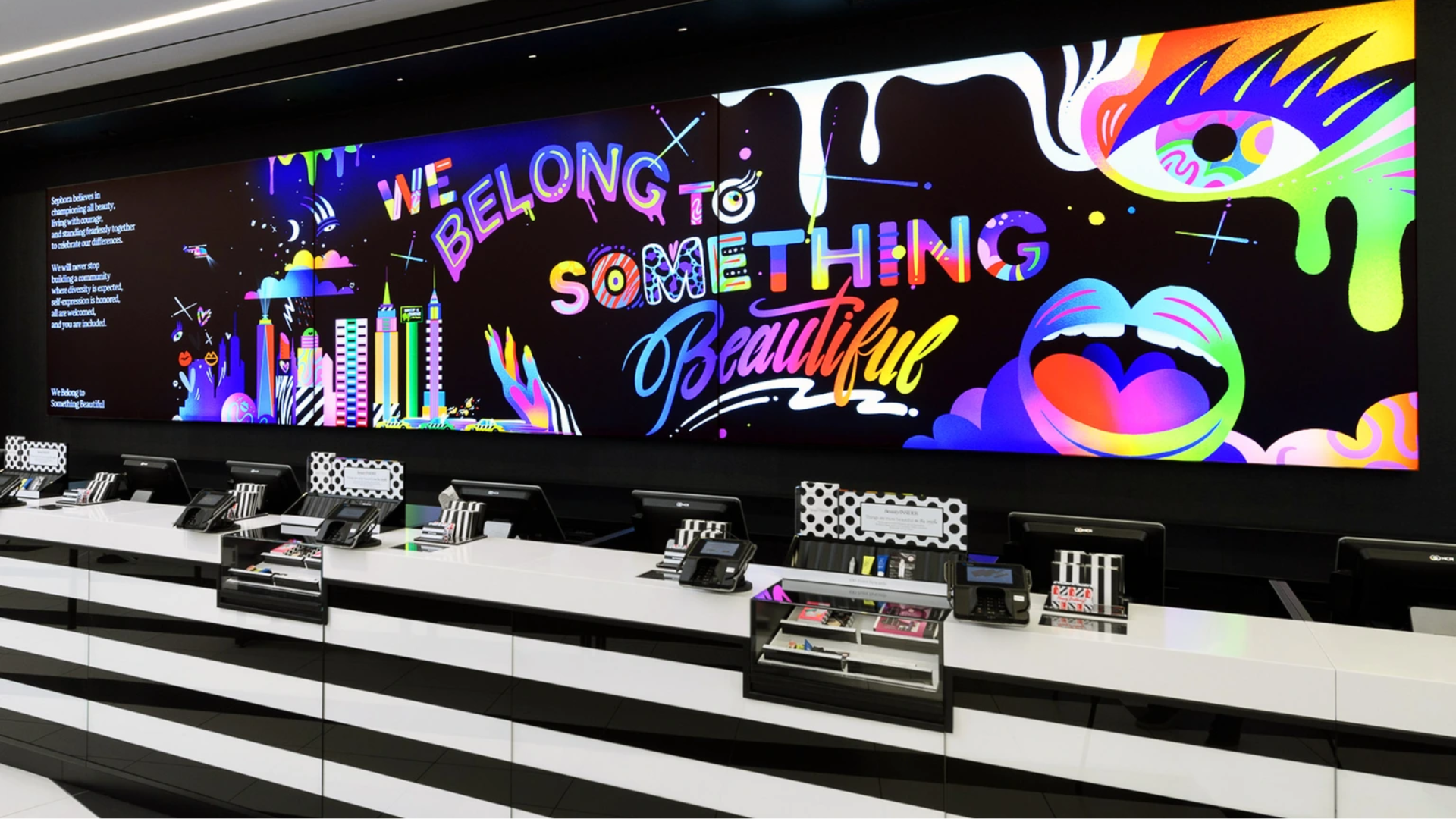
7.4. Digital Innovation Campaigns (Virtual Artist, Color IQ)
Sephora continuously promotes its proprietary technology tools like Virtual Artist (AR try-on) and Color IQ/Skin IQ (AI-powered personalization for foundation matching and skincare routines). The objective is to enhance the customer experience, reduce purchase friction (like finding the right shade), increase buying confidence, drive conversions, and gather preference data.
These tools are integrated into the mobile app and website and promoted through digital channels. They have achieved high engagement (e.g., 200M+ shades tried via Virtual Artist) and are credited with improving conversion rates and customer satisfaction by addressing key pain points.
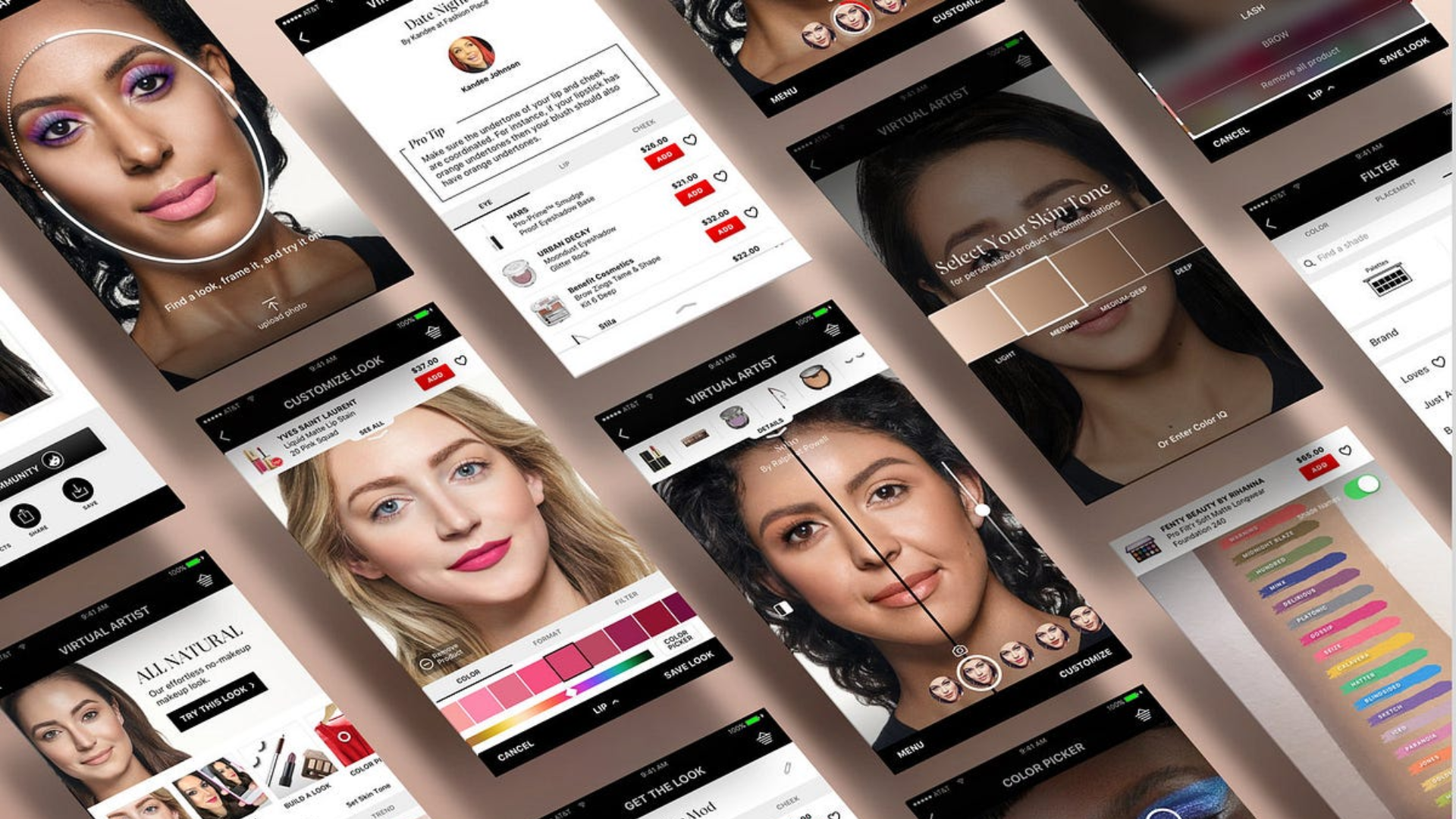
So, what can Shopify brands take from Sephora marketing strategy? It’s all about blending a standout product mix with smart pricing, a seamless online experience, and digital campaigns that pop—like their #LipStories or TikTok wins. For you, it’s a chance to use Shopify’s tools to mimic their SEO savvy, influencer vibes, and loyalty hooks, all while staying true to your brand’s vibe. Sephora proves that connecting with customers and outshining competitors doesn’t need a massive budget—just creativity and strategy. Ready to make your store the next big thing? Let Sephora’s playbook inspire your next move!

